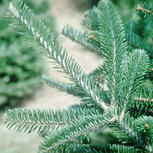
Fraser Fir
These are skinny and light green trees which hold their needles for a long time with little water.
These are skinny and light green trees which hold their needles for a long time with little water.
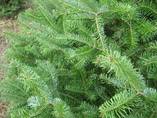
Balsam Fir
The Classic Christmas Tree with dark green, soft needles. Balsam Fir trees can be identified by the sap blisters on the trunks and, of course, the classic Christmas Tree aroma.
The Classic Christmas Tree with dark green, soft needles. Balsam Fir trees can be identified by the sap blisters on the trunks and, of course, the classic Christmas Tree aroma.
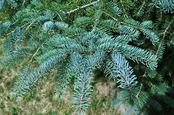
White Spruce
Slower growing, lighter green, sharp stiff needles
Slower growing, lighter green, sharp stiff needles
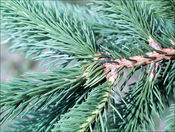
Norway Spruce
Fast growing, dark green, dense, sharp needles, light tan or orange twigs.
Fast growing, dark green, dense, sharp needles, light tan or orange twigs.
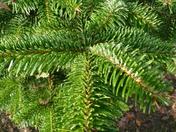
Nordmann Fir
This is a slow growing tree with longer, softer, darker green needles, strong branches, popular in Europe
This is a slow growing tree with longer, softer, darker green needles, strong branches, popular in Europe
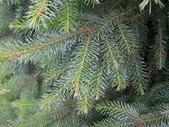
Serbian Spruce
These are similar to White Spruce, but have darker green needles on the upper side with a silvery accent on the bottom.
These are similar to White Spruce, but have darker green needles on the upper side with a silvery accent on the bottom.
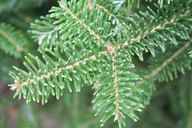
Canaan Fir
Very similar to Balsam Fir
Very similar to Balsam Fir
The Importance of Rainfall and Water
"Drought damage is the result of trees needing more moisture than what is available in the soil. It affects all ages of trees, but new transplants are the most vulnerable.Symptoms generally start at the top of the tree and continue downward and may include the loss of needles, fading or yellowing of needles, and overall slow growth. During extreme drought, tree mortality may occur (Figure 3). The effects of drought may be from one growing season of significantly decreased moisture or from several seasons of below-average rainfall. Drought also leads to other problems, especially insect pests and diseases." ~Francie Diep Penn State Extension
Other Articles to Learn More
"Drought damage is the result of trees needing more moisture than what is available in the soil. It affects all ages of trees, but new transplants are the most vulnerable.Symptoms generally start at the top of the tree and continue downward and may include the loss of needles, fading or yellowing of needles, and overall slow growth. During extreme drought, tree mortality may occur (Figure 3). The effects of drought may be from one growing season of significantly decreased moisture or from several seasons of below-average rainfall. Drought also leads to other problems, especially insect pests and diseases." ~Francie Diep Penn State Extension
Other Articles to Learn More
The Bunker Tree Farm is a "cut your own" Christmas Tree farm. The general public is welcome to come weekends starting December 2, 2023 and look through the field for a tree they would like. If you find one, we have flagging that can be used to "tag" a tree. You may put flagging around your tree and come back on a later weekend to cut it. Please do not tag a tree before December 2- all early tags will be removed. If you would prefer to cut your tree that same day, we have hand saws available at the shed.
